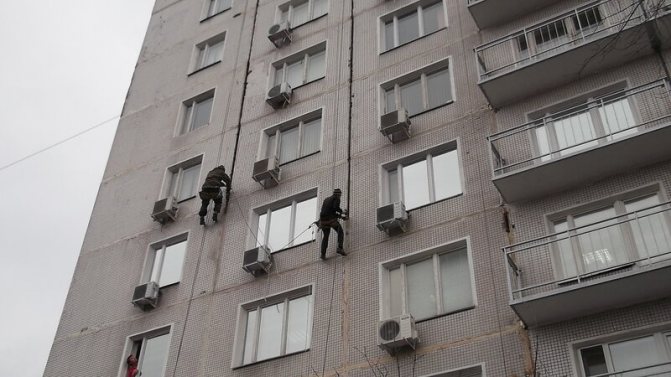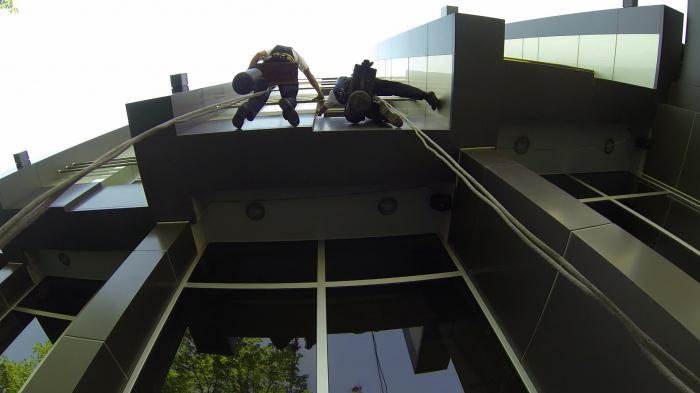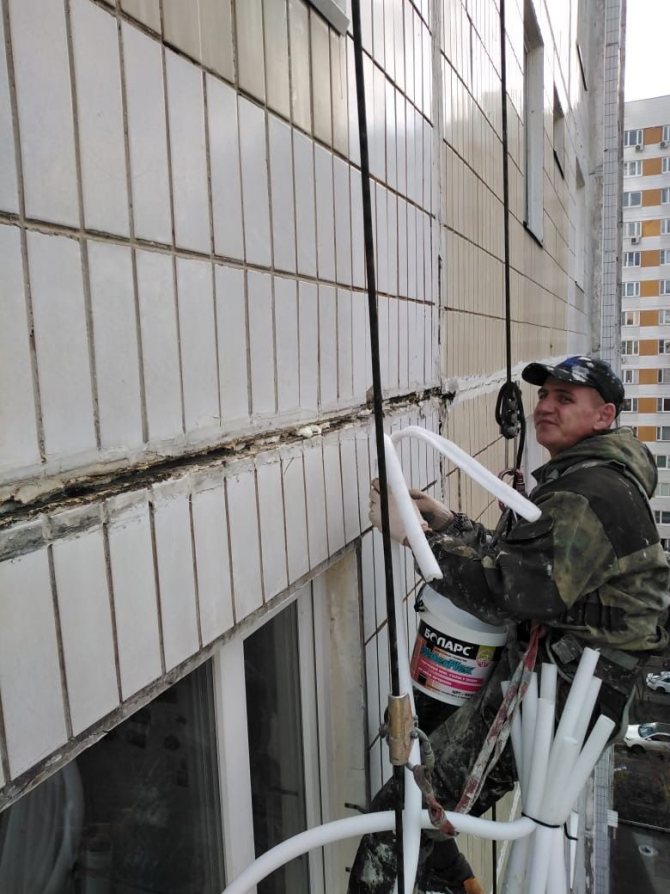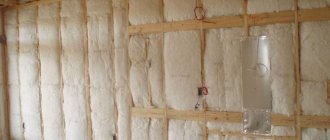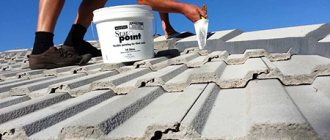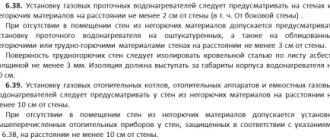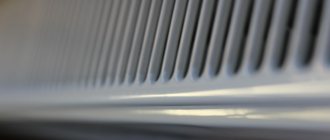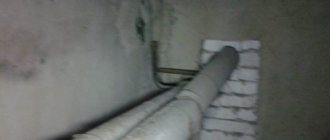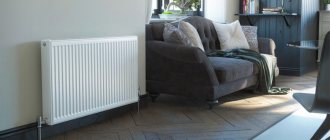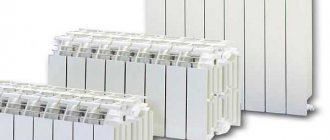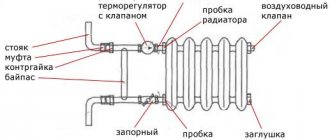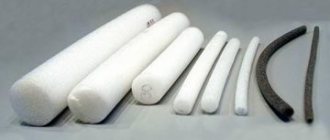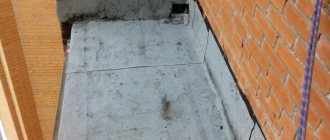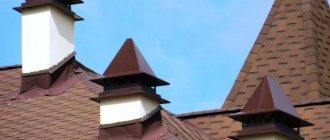The main causes of the destruction of interpanel butt seams
The following reasons for the depressurization of the joints can be distinguished:
- non-compliance with technological standards during construction;
- gradual displacement of wall panels due to uneven settlement of the supporting elements of the structure;
- deformation of panels due to temperature fluctuations;
- influence on sealed joints of atmospheric factors, such as "acid precipitation", snow and rain.
Sealing materials
For sealing and insulating interpanel joints, special sealing mastics and self-adhesive tape are used. These sealants come in a variety of brands, constituents and applications.
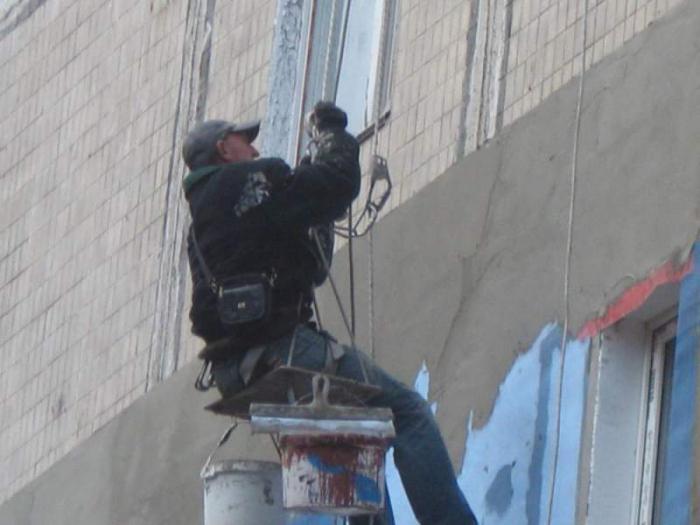
The main accompanying material necessary for sealing the joints is a sealant, which will perform a heat-shielding function, and is also the basis for the laid mastic and self-adhesive tape.
The best sealants are compounds based on expandable polyurethane (PPU). Due to these factors, the destruction and deformation of interpanel joints occurs, which leads to rapid freezing of the outer walls in winter, as well as their flow during heavy rains. As a result of this, not only can the interior of the building deteriorate, but also the risk of morbidity among the people there is significantly increased.
How to get the management company to close up the interpanel seams of the loggia outside in an apartment building?
Does the management company have the right to refuse to seal the outside seams on the loggia — the joints between the fence and the side plate, and if they are obliged to do the work, at whose expense and how to get it?
The maintenance of the common property is the responsibility of the management company and they cannot refuse.
The management company is obliged to close up the seams, since it is she who is responsible for the common property. Apply with a written application to the Criminal Code, and if they refuse, write a complaint to the housing inspectorate.
______________
Primary sealing
This type of sealing, as a rule, is performed in panel houses immediately after the completion of their construction.
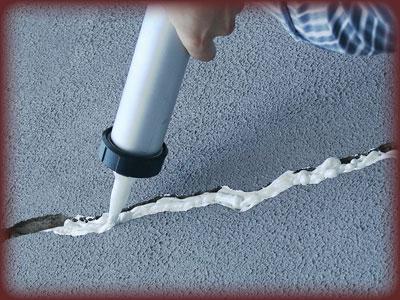

Interpanel seams of new buildings are processed in 3 stages:
- Empty interpanel cavities are filled with heat-shielding polyurethane foam.
- The interpanel seam is processed with an innovative insulation "Vilatherm", which is a fine-mesh, fairly light white material.
- Additionally, the seam is sealed from the outside with a special mastic with good water-repellent properties.
The use of these three stages allows you to create a so-called "warm seam", which allows you to provide reliable heat and waterproofing in all weather conditions.
Sealing prices:
- Sealing of a metal roof - from 150 rubles / r.m.
- Sealing the roof of the balcony - 7000 rubles / piece.
- Sealing double-glazed windows - 100 rubles / r.m.
Sealing of interpanel seams
- Primary sealing of interpanel seams (Vilaterm insulation + sealant) - from 200 rubles / r.m.
- Primary sealing with filling the seam with polyurethane foam ("warm seam" technology) - from 250 rubles / m.
- Secondary sealing of the seam (a layer of sealant is applied over the previous one) - from 180 rubles / r.m.
- Secondary sealing with disassembly and opening of the seam (Vilatherm insulation + sealant) - from 250 rubles / l.m. (warm seam +20 rubles / l.)
- Sealing of apartments (one-room) ≈ 10,000 rubles. (including materials Sazilast + Vilatherm)
- Sealing of apartments (two-room) ≈ 15,000 rubles. (including materials Sazilast + Vilatherm)
- Sealing of apartments (three-room) ≈ 22,000 rubles. (including materials Sazilast + Vilatherm)
Visit of a specialist to the object is free


How do we seal the seams
Sealing of interpanel seams by our specialists is performed by replacing the entire joint filler with a new one. At the same time, we restore the joints between building panels using the technology of "warm seams". Applying this technology, we will save you from any problems for many years that may be associated with a violation of thermal insulation and waterproofing of joints.
Stages of sealing works:
- opening and cleaning the seam, removing its contents
- sealing cracks in the facade and repairing joint elements
- drying the seam
- laying new filler
- sealing with special mastic
- joint sealing
Sealed interpanel seams are comfort and coziness in the house
If you need a warm and comfortable home, then you need sealing of interpanel seams. Our prices will not leave you indifferent, and will pleasantly surprise you. We employ highly qualified, experienced and hardworking industrial climbers, so our clients are always confident in the timing and quality of the work performed!
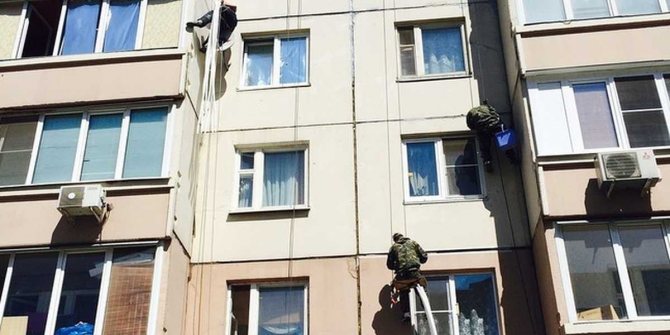

Interpanel seams. Sealing: general rules
Depending on the state of the seam, secondary sealing is divided into two types.
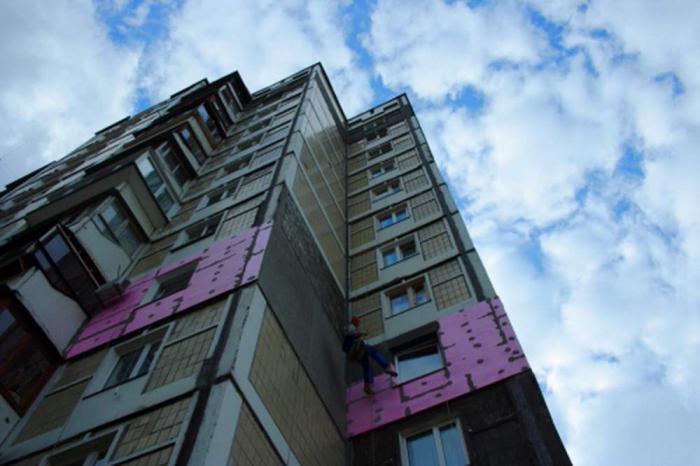

If its condition is satisfactory, if the old heaters have not undergone significant destruction, secondary processing can be limited only by applying a new outer layer of waterproofing mastic. If, however, all signs of severe destruction of interpanel seams are clearly visible, then when they are re-sealed, certain work is required. These include: opening the seam, removing all old fillers that have become unusable, and carrying out the entire range of sealing works, as when performing primary sealing.
When performing repair work on panel joints, it is necessary to follow some rules:
- In the case of leaking panel joints in the end wall, the interpanel joints of the entire end facade of the building, as well as the joints between the panels of the end and the longitudinal wall, are sealed.
- If the vertical joint of the longitudinal facade leaks, all vertical joints are sealed along the entire height of the house. In addition, all horizontal joints adjacent to it are sealed.
- If a defect is found in a horizontal joint, all joints located on three to four vertical rows of panels must be sealed.
- When carrying out repair work on panel joints, it should be taken into account that the sealants are subjected to tension and compression at the joints. This is influenced by temperature fluctuations, shrinkage and "creep" of concrete, as well as loads arising from the settlement of the entire building. Moreover, with an increase in the ratio of the thickness of the layer of the hermetic means to the width of the interpanel seam, such loads become stronger. For this reason, the sealant layer should be half the joint width.
Methods and technology for repairing joints
The main requirement for a high-quality repair is the use of correctly selected high-quality materials and step-by-step implementation of the work technology. Usually there are 3 repair methods:
- putty seams;
- waterproofing works;
- “Warm seam”.
Joint putty work is performed without opening it and replacing the sealant. The mastic is applied on top of it. This repair method is used in the absence of visible signs of a violation of the seam tightness inside the apartment, and the damage to the outer layer of the sealant is insignificant. These works are usually carried out during cosmetic repairs.
Waterproofing of joints occurs with their complete cleaning and replacement of the sealant. Insulation of the joints is not done in this case. Usually one-component polyurethane sealant is used for interpanel seams and joints Hermaflex 127.This material is ideal for insulating vertical joints, has a wide range of temperatures (-50 ° C ... + 80 ° C), quickly hardens. White or gray, compatible with all types of facade paints. The warranty period is 8 years. Sealing interpanel seams using this technology will help protect them from moisture, but cold will penetrate into the room through unsealed horizontal joints. Sealing external seams is work to prevent the ingress of water into them. For this, waterproofing compounds are used and the seam between the panels is filled with polyurethane foam, which creates a warming effect.
Thus, the foam is completely between the boards and protected from UV rays. This extends its service life. The sealant protects the board joints and prevents water from entering them. As a result, the sealed joint excludes the appearance of mold and mildew in the room.
[flat_ab id = ”35"]
Sealing of interpanel seams. Technology
Interpanel seams, the sealing of which should occur as efficiently as possible, are processed in several stages. For the most durable sealing of expansion joints, it is necessary to open them.
We propose to consider the step-by-step repair of panel joints with opening.
The following sealing of butt joints in panel houses is called a "warm joint". Its main difference is the application of a layer of special heat-protective foam to the base of the seams.
Such a repair of seams has passed a large number of tests and has been successfully used for a long time in many countries of the world.
Where to apply for interpanel seams?
We have Sevzhilservice management company.
In the corner room, it pulls strongly along the floor precisely from the side of the end wall. From the street you can see that all the putty has fallen off.
Where to contact? And another question: is it closed only in the summer?
A written application to the Criminal Code (what do you have from Sevzhilservices, CJSC or LLC - see the receipt) addressed to the manager by registered mail with a return receipt to the legal address. Usually they include it in the address program for the summer, they will write you a piece of paper, but be prepared that they will not execute it right away, the dynamo is the SGS style of work.
_____________
- We have a different management company. We first wrote a statement, then every month we called by phone. with the question when will the seams be sealed? Either the weather was bad, then the high-altitude climbers left for another area. As a result, after half a year they came to cover it up. It was two weeks ago)))
- They wrote to the Criminal Code (by registered letter with notification), + called their director personally, literally after the conversation on the trail. in the morning at 8.00, the director himself came, assessed the situation and, oh, miracle, after 2 weeks high-altitude workers appeared in the window, hanging on a rope (the children were waving their pen to them) As a result, a month passed from the moment of filing the application until the end of the work ...
- We also got the work permit that year. Now the MANAGEMENT COMPANY will repair the interpanel seams. They called the housing department, a woman came, drew up an act and sent it to our Criminal Code, after a while a letter came that they would soon do it ... They did not lie, they repaired everything !!
- As announced in the Criminal Code, the repair of apartment buildings is carried out by 20% at the expense of homeowners, and 80% from the budget of the Criminal Code or the city budget (I did not really understand), but the subtext is that everything rests on the budget, but the fact that residents deduct it very little. And how much do you have to pay then?
______________
Features of the cosmetic repair of the seam
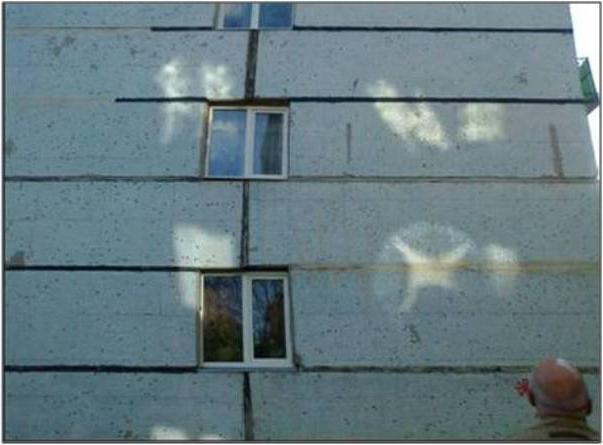

For the reason that the sealing of the seams at home can be done qualitatively only from the outside, you need to prepare well the components of the mixture, which are stirred with a mixer. Sealant is applied to the seams with a spatula, the width of the tool is selected depending on the dimensions.It is recommended to seal the front edges of the panels with masking tape, which is removed after processing with mastic. This allows for a more aesthetic surface.
Sealing joints in houses of various series.
The method of sealing joints between panels depends primarily on the series of the house, its features and the design of the panels. Also, during the work, the economic component of a particular sealing method is taken into account.
Tight seam sealing technology is one of the most effective and reliable ways to seal joints. It's all about a special method of filling and warming the interpanel seam with mandatory waterproofing. For work, such materials resistant to various influences are used as: wear-resistant polyurethane sealant "Vilatherm", sealing compound "Macroflex" and mastic "Oxyplast". The implementation of all technological processes for sealing joints depends on the series of the house.
The houses of the famous KOPE series were built using hollow concrete sandwich panels. Since they are not airtight, the heat is not retained in them, and cold and humid outdoor air freely enters the living quarters. Sealing interpanel seams using traditional polyurethane foam is not suitable for such panels, since the sealant spreads through the voids without fixing the seams themselves. To improve the quality of sealing, we use a reliable seal "Vilatherm". It is he who fills the interpanel joints well and insulates the entire wall panel. During the work, the specialists eliminate the defects and defects of the sandwich panels.
Panel houses of the popular series 44, 44t are known for problems that periodically arise due to chips in the panels and the presence of too large distances between the joints, through which moisture and cold outdoor air continuously pass. In such houses, it is rather cold in winter, the walls are usually "decorated" with mold and condensation, and intense air currents are formed in the area of ceilings and floors. Sealing of interpanel seams in such houses is carried out using the "Warm seam" technology. In the event that the joint is not so wide for the use of Vilaterm filler, the seams can be thoroughly foamed and thoroughly covered with a sealant. Polyurethane foam, closed from direct environmental influences, is capable of performing its functions for a long time.
Monolithic brick houses also "suffer" from poorly sealed joints. But the joints are between the brickwork and the monolithic floor. In addition, problems often arise at the junctions of window structures and walls. All these joints and abutments also need insulation and sealing.
Features of the work
Manipulations should be started with opening the seam along the entire length, the sealant should be removed, and the edges of the panels, if necessary, restored. The surface must be treated with a primer. The seam must be sealed with foam, given its expandability. After the foam starts to increase, you need to put a seal made of expanded polyethylene on top. This will prevent foam from escaping to the outside. This seal is manufactured in the form of hollow tubes, but solid tubes are also available. The dimensions of this material should be fifteen centimeters greater than the seam width. In its place, it is installed using a spatula, the element must be pressed into the layer of polyurethane foam. Care must be taken during installation to ensure that the material is not damaged. In this case, a tape can also be used to seal the seams. This technology is considered the most effective and modern today. Its use allows you to heat insulate the seam, making it waterproof, which will provide reliable protection of the home from external negative factors, and increase the service life of the building.Sealing in multi-storey buildings should only be done with professional support.
How to apply for seam repair
To understand why it is cold or damp in your apartment, you need to call the specialists of the Management Company. They will conduct a comprehensive survey of the apartment: inspect the interpanel seams and walls; check the level of humidity, the condition of ventilation and windows; take temperature measurements. After that, experts will draw up a conclusion and tell in detail what is the cause of the cold and advise where to go.
“To document your appeal, you must write a statement and bring it to the office of the management company, where it should be registered,” says Oksana Kolk, head of the media relations department of the City Manager. - After that, during the heating season, a specialist comes to the apartment, who assesses the condition of the interpanel seams, the degree of their freezing. Based on the results of the inspection, an act is drawn up. So the apartment gets into the queue for the repair of interpanel seams. I note right away that this is seasonal work, which is performed only in warm, dry weather.
Repair with partial opening of the seam
If part of the coverage is broken or there is a certainty that there are no seals behind the cement screed layer, then the sealing must be done in the following way:
- The damaged cement coating is removed. If only a small part of the seam is opened in this way, it is necessary to drill every 20-25 holes (with a 10-12 mm drill).
- After that, the voids behind the plaster are filled with polyurethane foam. For this purpose, it is better to use a special gun, for which it is more convenient to dispense the amount of foam, which makes it possible to reduce its consumption.
- After the foam hardens, its protruding part is cut off. The entire seam is treated with a primer, and the exposed areas and drilled holes are plastered. The final step will be to seal the seam with mastic.
ZHEK does not want to seal the interpanel seams. What to do?
Sasha Novikov Student (15), closed 2 years ago
House since 1980. Panel seams have never changed. In winter, there are drafts and cold in the apartment. I wrote an application to the management company to replace the seals between the panels in the entire apartment, and they told me that they could only replace 30% of the entire apartment, because more of this is already going as a CAPITAL REPAIR and they cannot. The only question is, is it true? Why can't it be done in the whole apartment at once?
This is the responsibility of the service organization. To help you -Decree of the State Construction Committee of the Russian Federation of September 27, 2003 N 170 "On the approval of the Rules and norms for the technical operation of the housing stock" https://base.consultant.ru/cons/cgi/online.cgi?req=doc;base= LAW; n = 44772 See IV. Maintenance and repair of building structures. Read the entire section 4.2. Walls. 4.2.1. The walls are stone (brick, reinforced concrete). 4.2.1.1. The organization for servicing the housing stock must provide: a given temperature and humidity regime inside the building;
good condition of the walls for the perception of loads (structural strength);
elimination of damage to walls as they are identified, preventing their further development;
heat protection, moisture protection of external walls.
4.2.1.7. Panel joints must meet three requirements:….
Butt joints with leaks must be sealed from the outside with effective sealing materials (elastic gaskets and mastics) by specialists as soon as possible (in small volumes during the preparation of houses for winter).
4.2.1.12. Areas of walls that freeze or damp due to insufficient thermal protection, as well as walls with low thermal resistance in hot regions, must be insulated. What to do? - you have already been given advice. Good luck!

